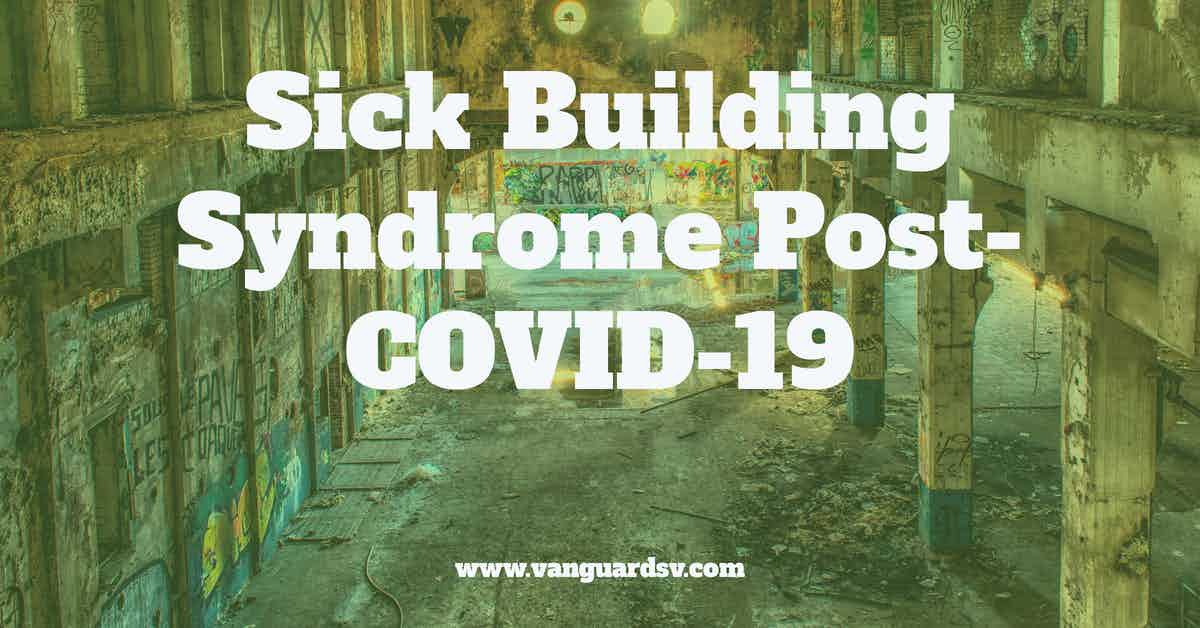Sick building syndrome--the unseen killer of workplace health and productivity--is rapidly being thrust to center stage as efforts to combat the SARS-CoV-2 pandemic have both improved and simultaneously eroded indoor air quality.

Sick Building Syndrome and SARS-CoV-2
Sick building syndrome is a disorder typically traced to the indoor environment and air quality of a particular facility that afflicts occupants while present in the building with a wide range of symptoms commonly observed in cold and flu infections, but where the symptoms almost always abate shortly after exiting the building.
According to HealthDay;
"[S]ick building syndrome" -- a constellation of symptoms that usually includes fatigue, headache, dry, itchy skin, and irritation of mucous membranes in the eyes, nose, and throat.
Unlike building-related diseases, these symptoms tend to disappear once people are out of the suspect building.
But not always.
In some people, the constant exposure of working in a sick building can trigger sensitivities and auto-immune conditions that are difficult to treat.
Studies have estimated the financial impact of sick building syndrome to range as high as $75 billion annually.
When combined with other challenges, such as side effects from inhaling tobacco smoke, communicable respiratory infections transmitted in a building, such as influenza, respiratory ailments complicated by building conditions, such as asthma or allergies, and respiratory diseases directly attributable to the building, such as legionaries, the number skyrockets to as high as $100 billion annually.
According to the National Institutes of Health;
The most uncertain estimate—and, at $20 to $70 billion, the largest—is that for productivity losses from building-related symptoms.
The estimates [...] indicate that the combined annual costs of these adverse health effects range from $50 to $100 billion, with about $5 to $75 billion potentially preventable.
The SARS-CoV-2 pandemic has had both a positive and negative impact on indoor air and environmental quality and has positively and negatively affected sick building syndrome rates and sufferers.
On the one hand, the science behind the spread of SARS-CoV-2 shows that increasing airflow through a building helps disperse the airborne microbes and reduce transmission rates.
The increased airflow also disperses volatile organic compounds and other pollutants in the air, positively impacting occupant health, and is a known method for reducing sick building syndrome complaints.
Conversely, especially early on, the increased use of commercial disinfectants to kill SARS-CoV-2 negatively impacts indoor air quality and offsets the benefit of increased airflow.
According to Kaiterra;
[...] the use of sanitizers and disinfectants enormously increased in response to COVID-19.
These products are necessary for eliminating the virus, but most cleaning products significantly harm indoor air quality.
Chlorine-containing products, quat-containing products, and hydrogen-peroxide-containing substitutes produce chemical byproducts that pose substantial health risks, especially for those exposed on a consistent basis like janitors and cleaning staff.
Conversely;
Anything that improves indoor air quality will most likely help stop both COVID-19 and sick building syndrome.
Ventilation, for instance, is key for both COVID-19 and SBS risk reductions. Outdoor air is free of COVID-19 droplets and indoor chemicals, so increasing the introduction of fresh air both lowers the risk of COVID-19 and reduces the presence of indoor air pollutants that contribute to sick building syndrome.
Addressing the clearly enormous burden of indoor air and environmental quality will require a two-pronged approach that focuses on:
- Increased airflow, and;
- The elimination of products and chemicals that reduce indoor air quality.
Addressing the Challenge of Indoor Air Quality and Airborne Respiratory Disease
Increasing indoor airflow is a documented method for addressing airborne respiratory diseases, such as COVID-19 and sick building syndrome.
Additional steps that should be undertaken to maintain facility surface safety and hygiene without negatively impacting air cleanliness are:
- Increasing cleaning frequencies with commercial-grade detergents and microfiber, which are considerably less toxic than commercial or hospital-grade disinfectants.
- Reducing facility-wide disinfectant applications to times when outbreaks occur in the local community, when a contagious person compromises the facility, or when increasing instances of infection are attributed to the facility itself.
- Using a targeted approach to disinfectant applications by focusing on documented fomites.
- Using products that are registered with the US Environmental Protection Agency against the pathogens or pathogenic bacteria you are combatting, and that are considered safer and less toxic by the Environmental Working Group.
- Installing UVC air sanitation systems inside of HVAC ducts.
- Installing MERV-13 or higher rated filters in the HVAC system, and;
- Installing commercial-grade air cleaning systems in occupied areas of the facility, especially where occupants spend most of their day working.
Takeaway
The SARS-CoV-2 outbreak underscored the need for improved facility safety and hygiene protocols, including how air flows through a building, what products are used to sanitize the facility's surfaces, and when and how those products should be applied to maximize occupant health and safety.
Sick building syndrome is a malady experienced by millions of US office workers that costs American businesses tens of billions of dollars every year.
Dealing with the COVID-19 pandemic simultaneously improved and reduced indoor air quality by increasing airflow and increasing the use of highly toxic disinfectants.
Addressing both challenges requires the tools and services of experienced custodial teams.
Outsourcing is an established method for onboarding critical janitorial labor resources, tools, and products at a fraction of the cost of maintaining a comparable service in-house.
If you would like more information regarding the effectiveness of high-performance infection prevention and control measures, or if you would like to schedule a free, no-obligation onsite assessment of your facility's custodial needs, contact us today for a free quote!
In Bakersfield, CA, call (661) 437-3253
In Fresno, CA, call (559) 206-1059
In Valencia CA, or Santa Clarita CA, call (661) 437-3253
In Palmdale, CA or Lancaster, CA, call (661) 371-4756

